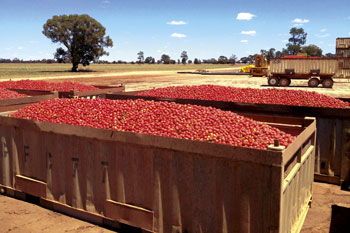The RFID technology in the food tracing
Switching from the paperwork to an automated identification solution, Sick supported its client in the food sector to ensure tomatoes traceability right from the harvesting phase. And with a lot of benefits to the production
by Marco Catizone
The Japanese tomato processor Kagome boasts more than 100 years’ experience in the tomato growing and processing industry. Since 2010, Kagome Australia’s factory based in Echuca has been cultivating and processing tomatoes, by providing high-quality tomato products to food companies in Australia. RFID technology from Sick allows Kagome to ensure product traceability and leads to increasing efficiency in the production process.
From the use of paperwork to an automated identification solution
On the Echuca fields, Kagome operates 12 harvesters loading tomatoes into more than 300 huge bins, each with a capacity of 14 tons. Once a bin is full with fresh tomatoes, it is unloaded at a bin pad, waiting for one of 12 trucks to pick it up and take it to the weighbridge close to the factory. One trip from the fields to the Kagome factory takes approximately 90 minutes and each truck can load three bins – that is an average of around 42 tons of tomatoes per truck. There used to be long truck queues at the weighbridge, and the truck drivers had to wait for 12 minutes until they could get out of the truck to have the tomatoes weighed. As part of Kagome’s quality control process, three samples from each bin had to be processed in the laboratory because it was not obvious which tomatoes came from a Kagome farm.
In addition to that, the drivers had to prepare paperwork to document the harvesting process as well as the quantity and quality of the yield. This process increases the potential for human error in a paper-based quality control system, which can result in contaminated products reaching the consumer, conceivably creating widespread foodborne illness. So to ensure traceability, it was time to look for a paperless automated identification solution to be implemented at the weighbridge.
Improving the harvesting process thanks to using the RFID technology
RFID technology (radio frequency identification) is increasingly found in food tracing as technology improves and prices come down. Implementation is not uncommon in the case of large containers containing raw products and in the mixing of bulk materials. It offers companies a number of ways to streamline and manage their capacities, focusing particularly on the issues of trace-ability and process reliability. Using wireless technology for identification purposes opens up a new dimension in automatic data recording. The automotive industry has been utilizing RFID for years, where a tag is attached to the car body and is encoded with data options for each vehicle. RFID tags offer more functionality than bar code technology, as they are read/write devices and no visual contact of the tag is required. Moreover, they are very robust so that they can even survive harsh ambient conditions.
Six devices for more than 500 tons productivity gain
Kagome in-stalled six RFU63x units from Sick, each equipped with three antennas for double stacked bins, at the weighbridge and discharge hill at the factory in Echuca. Resistant and stable RFID tags were attached to the tomato bins, accompanying them right from the start of the harvesting process. As a result, the RFU63x entirely meets Kagome’s requirements set out for paperless automated identification of tomatoes. In this way, RFID helps to prevent the typical errors made during inbound and outbound goods processes, for example incorrect quantity and quality data, or missing accounting entries. RFID allows real-time identification of where the tomatoes come from. Due to paperless identification, no truck driver has to leave the truck at the weighbridge anymore and the driver safety is enhanced. This efficiency gain means that the truck is spending less time at the weighbridge, and that truck jams in front of the weighbridge and the tomato drop hill have become a thing of the past. As the truck time at the weighbridge has been reduced from previously 12 minutes to 2 minutes, the truck driver can go for an extra trip per 12-hour shift. This means a productivity gain of 504 tons in total, which is achieved thanks to using the new RFID.
Autore: Marco Catizone, Head of Industrial Integration Space and Shared Services Unit in Sick

